
|   |

|   |
Jharna - a fountain of beauty - Sandhya Shankar e-mail: sandhyashankaris@gmail.com Photos courtesy: Bharatakalanjali March 16, 2022 It was two weekends of wonderful display of dance, music and tholbommalattam at the Dhananjayan's school Bharatakalanjali. It was an idea born out of this school's alumni and now a Creative & Executive Director of Bharatakalanjali, a senior Bharatanatyam artiste of her own merit, Shobana Bhalchandra's passion. The whole idea of having twelve performances of about one hour each stretching over two weekends, including Fridays, was to give an opportunity to young talented artistes to show their creativity and competence. In order to truly encourage them, they were all remunerated. 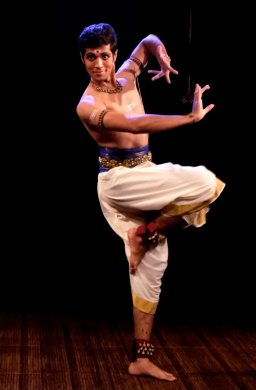 Srinivasan The festival started on the 11th of February for a niche live audience, and it was also streamed online. Srinivasan, one of Bharatakalanjali's students gave the first performance in a traditional manner. Srinivasan chose to dance as the all time hero Bharatiyaar. Bharatiyaar enters seeing this beautiful world and enjoys the development that has taken place. He notices that women are using their freedom in a right way and proving how they are also equal to men by qualifying themselves educationally. The feminist that he was, this sight makes him very happy. He was early to recognize woman power and the need to empower them...this is evident in many of his poetry. But this happiness is short lived because he sees women misusing their freedom by not taking their responsibility towards family, thinking being that way is a proof of equality. Imagine, if this was his disappointment years ago, what could be his level of disillusionment now if he saw today's social standards and family dynamics. He is also surprised and amused by seeing the scientific developments, like he wished (ie:-bridge connecting Srilanka, river water connection, telephone). Anyway in the end, Bharatiyaar is very happy about what happened in totality and he leaves in a happy state. Srinivasan's performance was good and had no mistakes but he certainly has a long way to go. The next person to perform was Shreema Upadhyaya from Bangalore. One of the nice things about Jharna was that we could see talent from other parts of the country. Every time I read or hear the Mahabharata, I wonder who complemented who; was it Drona who was known to be a teacher par excellence to have produced a student like Arjuna or was it Arjuna who made Drona famous by being such a talented and extraordinary archer. I guess both needed each other. What can satisfy a teacher more than watching one of his students perform wonderfully and bringing laurels to the teacher.  Shreema Upadhyaya Sometimes, wonderful things come in small packages and that is the case with Shreema - small and petite, yet a tower of talent. Her first piece was Krishnanjali, where Krishna is the irresistible bundle of innocence, mischief, compassion, and wisdom. His entire avataram has been fascinating for all, be it an artist or an artiste or an ordinary man - to bring out his various facets and roles such as the dearest lover of the Gopis, as the protector of the distressed when he is Govardhana Giridhari and so on. When Arjuna faces a dilemma at the battlefield of Kurukshetra war, having to choose between giving up his fight for righteousness and slaying his own brothers and friends, it is then that Krishna gives the greatest treasure to mankind, the Bhagavad Gita. Shreema presented an excerpt from the Sri Krishna Kamalanatho varnam, composed with verses from the Sri Krishna Shatanamavali Stotram, set to raga Reethigowla and adi tala. She showed agility and a range of expressions that one couldn't but admire. Her next piece was a javali, in which her expressions are of a khandita nayika of anger and disdain towards her lover, whose actions have cheated her, and she doesn't believe or accept his remorse. This piece in Kannada 'Saako Ninna Sneha' is in raga Kapi and mishra chapu tala, and composed by Venkatagiri Shastri. I particularly loved this piece, (knowing the language helped) where Shreema was at her best; in her one could find everything a lover could be - angry, hurt, disappointed, yet the nayika is unable to stop loving her man. Shreema's last piece was very philosophical where the central idea is that one should treat the human body as a temple. She chose to elaborate this through a jathiswaram in raga Todi, adi tala, composed by Swathi Thirunal, followed by a vachana, Ullavaru Shivalaya Maduvaru, a composition of Basavanna. Lingayats who are followers of Basavanna, are expected to consider the human form sacred and their scriptures describe its sanctity and godliness. Just as a shrine houses the deity, so does the body act as a vessel for our soul. Rarely do we see dancers performing to Basavanna's vachana. The Jharna had begun to flow and beautifully so. 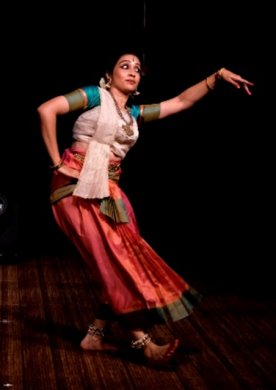 Divya Nayar It was with a lot of expectation that I went the next day, after a lovely experience the previous evening. The first artiste of the day was Divya Nayar, a student of both Kalakshetra and Sheejith Krishna and who is currently a teacher at Isha Sanskriti at Coimbatore. What struck me at the outset was Divya's creative costume and her striking stage presence. It was very intelligent on her part to have designed a simple and yet elegant costume, keeping in mind the intimate space and audience she was performing to. There was less jewellery and the colours were pleasing to the eye, not overpowering but impactful. Her performance was highly impressive, and she had chosen a single piece to perform Agame Vrindavanam - the last few verses from Nachiyar Thirumozhi. In Vaishnavism, the most popular and loved Alwar is Andal and her most famed work Thiruppavai. A poetess who has no parallel and her Nachiyar Thirumozhi is a lesser-known work. This is a collection of not just exquisite but erotic verses, where Andal's quest culminates with a surefooted gait into the inner world of her heart. The richness of Andal's poetry and the lyrical beauty was matched with Divya Nayar's emotive dancing. The grace and ease she showed in depicting Andal's complete and obsessive love and fanatic devotion, was an all-consuming thing. It is not a simple but a multidimensional experience she had, enjoying the Lord as a child, a lover, a friend, and a saviour. Mayane! You elude me as I look for you but pervade the world within my closed eyes! Divya mesmerised me with her performance.  Devika Venkatasubramanian After a small break, we had Devika Venkatasubramanian from Mumbai, who started her performance with a varnam in ragam Kharaharapriya and adi talam, composed by guru K.N Dandayudhapani Pillai. This varnam (Mohamaginen) was the nayika's narration to her Sakhi about her longing for lord Shiva. Devika expressed this longing with her eyes and every movement while exhibiting her excellent footwork and talent. Devika herself had choreographed the second piece which spoke about Lakshmana's wife Urmila's agony. How little is spoken about sacrifices of Urmila in the Ramayana. After all, Urmila didn't expect her marriage would end up like this. No one consulted her, especially her husband, before he took the decision to accompany Rama to the forest. She surely didn't bargain for this situation, as an outcome of Kaikeyi and Dasaratha's negotiations. Why should her life turn topsy turvy? Yet Urmila's commitment was to stay in Ayodhya and not go back to Mithila until Lakshmana returned and while Sita was stubborn about not separating from her husband, Urmila was forced to separate for no fault of hers. History has not given her the place she deserves. Imagine today any wife accepting such a situation and continuing to live with her in-laws! The lyrics which were beautifully composed in Tamizh by Prof. Dr. S. Raghuraman, talks about Urmila's birth, life, adroitness, and some lesser-known facts about her. Devika had chosen to choreograph this piece in the format of a padam interspersed with some spoken dialogues in the presentation. 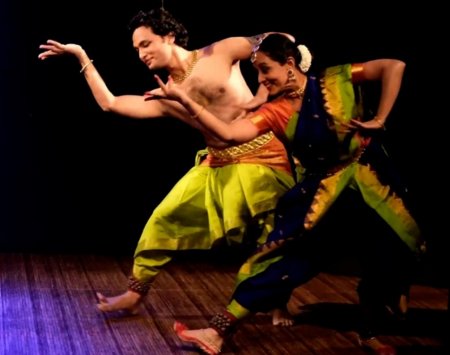 Uttiya Barua & Anita Unnikrishnan On Day 3, the program started with a creative piece by Bharatakalanjali's own senior faculty Anita Unnikrishnan with Uttiya Barua. Anita is not just a talented dancer herself, but a stage actress, who has been mentored by none other Shobana Bhalchandra. She was light on her feet and with Uttiya, another Bharatakalanjali student, gave a memorable performance. Remember the magic the Dhananjayans as a couple have created on stage (and off stage). As teachers they seem to have not just transferred knowledge but also some of their magic. The inevitable choice was Krishna who is an embodiment of love, tenderness and compassion. Krishna who is the most loved prankster, and a lover who every woman wants in her man; also he is the child every mother sees in her own child. He is acknowledged as God and yet he is celebrated as a child, lover, protector, a teacher, a strategist, a destroyer of evil and most important he represents limitless joy. The dancers couldn't have better conveyed that Maya is an experience to love and to be loved. When Maya is an illusion, how can anyone depict Maya through dance? But Uttiya and Anita could show all this in their performance. After watching such an enthralling performance by Uttiya Barua and Anita, we had a virtual Carnatic music concert by Kaustubh Chandramouli. Kaustubh was a good singer but this was a dampener, because all we did for the last two years was watch every concert virtually. 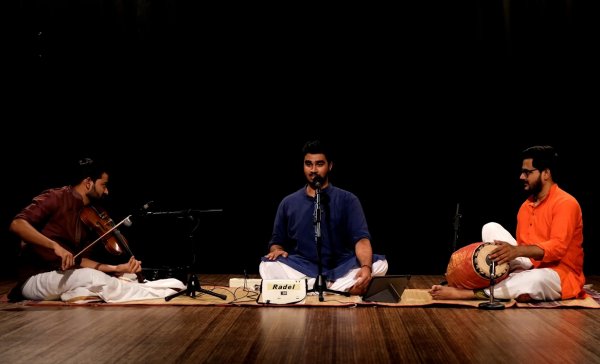 Kaustubh Chandramouli 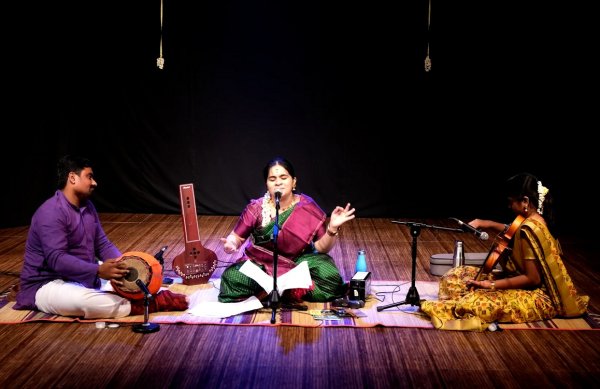 Ramya Ramakrishnan The last performance of the evening was a Harikatha by Ramya Ramakrishnan. She actually presented a Mudra Harikatha titled Sarvam Brahmamayam. I was hearing and watching a Mudra Harikatha for the first time. Only later did I know that she has been a Bharatanatyam dancer for over a decade, so I guess showing mudras was something which came naturally to her. She is also trained in Carnatic music for several years and currently learning the art of Harikatha from none other than Vishaka Hari. Ramya's Harikatha for the evening was on the life of the great Sidha Purusha and Carnatic composer Sadasiva Brahmendra who lived in the 18th century in South Tamilnadu. Her discourse was a complete coverage from his childhood, his learning Vedas and Shastras, his miracles, his musical compositions and finally attaining samadhi. The feeling one got seeing her was - what a big influence a teacher has over a student! Her narrative style, her more than necessary elaborate singing, even her humour was so like Vishaka's. It is in a way very nice, that a young person like Ramya, who has a full-time career, is pursuing this vocation out of her own interest. Of course, she still has a long way to go, before we see her blossom into a Vishaka minus the madisaar saree! 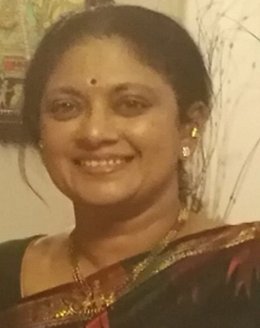 Sandhya Shankar belongs to a respected business family in Chennai. She is a Life Skills & Corporate Trainer by profession. An avid reader, she has written several poems and articles. She has keen interest in all art forms and has explored many different forms of painting like stained glass and Tanjore being among them. She is a trained musician. Her witty reviews have gained a loyal and interactive readership. |